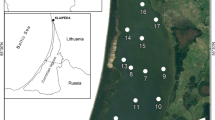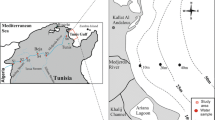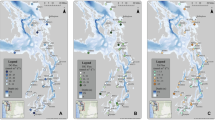Abstract
Bottom-water hypoxia effects on sediment–water interface nitrogen (N) transformations in Corpus Christi Bay (TX, USA) were examined using continuous-flow intact sediment core incubations. Sediment cores were collected from three sites in August 2002 (summer hypoxia) and April 2003 (normoxia). Oxygen (O2) and hydrogen sulfide (H2S) depth profiles were generated with microelectrodes. Membrane inlet mass spectrometry was used to measure sediment O2 demand and net N2 flux and combined with isotope pairing to determine potential denitrification and N fixation. Potential dissimilatory nitrate reduction to ammonium (DNRA) was measured using high-performance liquid chromatography. Sediment O2 penetration depths ranged from 5 to 10 mm. H2S ranged from being present in overlying water and throughout the sediment column in August to not detectable in overlying water or sediment in April. Sediment O2 demand was higher during bottom-water normoxia conditions versus hypoxia. Sediments were a significant source of \({\text{NH}}_{\text{4}}^{\text{ + }} \) to overlying water during hypoxia but not during normoxia. Net N2 fixation was observed at one station in August and all stations in April. Denitrification rates were significantly higher during hypoxia at two of three sites. Potential DNRA was observed during both oxic states, but rates were significantly higher during hypoxia, which may reflect sulfide enhancement and absence of cation exchange with \(^{{\text{14}}} {\text{NH}}_{\text{4}}^{\text{ + }} \). DNRA may contribute to formation and maintenance of bottom-water hypoxic events in this system. These results show that N transformation pathways and rates change when bottom-water O2 concentrations drop to hypoxic levels. Since south Texas is a semiarid region with few episodic runoff events, these results indicate that Corpus Christi Bay sediments are a N source most of the year, and denitrification may drive N limitation between episodic runoff events.






Similar content being viewed by others
References
An, S., and W.S. Gardner. 2002. Dissimilatory nitrate reduction to ammonium (DNRA) as a nitrogen link, versus denitrification as a sink in a shallow estuary (Laguna Madre/Baffin Bay, Texas). Marine Ecology Progress Series 237: 41–50.
An, S., W.S. Gardner, and T. Kana. 2001. Simultaneous measurement of denitrification and nitrogen fixation using isotope pairing with membrane inlet mass spectrometry analysis. Applied and Environmental Microbiology 673: 1171–1178.
Breitburg, D. 2002. Effects of hypoxia, and the balance between hypoxia and enrichment, on coastal fishes and fisheries. Estuaries 254B: 767–781.
Brendel, P.J., and G.W. Luther. 1995. Development of a gold amalgam voltammetric microelectrode for the determination of dissolved Fe, Mn, O2, and S(-II) in porewaters of marine and freshwater sediments. Environmental Science and Technology 293: 751–761.
Brunet, R.C., and L.J. Garcia-Gil. 1996. Sulfide-induced dissimilatory nitrate reduction to ammonia in anaerobic freshwater sediments. FEMS Microbiology Ecology 21: 131–138.
Buzzelli, C.P., R.A. Luettich, S.P. Powers, C.H. Peterson, J.E. McNinch, J.L. Pinckney, and H.W. Paerl. 2002. Estimating the spatial extent of bottom-water hypoxia and habitat degradation in a shallow estuary. Marine Ecology Progress Series 230: 103–112.
Childs, C.R., N.N. Rabalais, R.E. Turner, and L.M. Proctor. 2002. Sediment denitrification in the Gulf of Mexico zone of hypoxia. Marine Ecology Progress Series 240: 285–290.
Diaz, R.J., and R. Rosenberg. 1995. Marine benthic hypoxia: A review of its ecological effects and the behavioural responses of benthic macrofauna. Oceanography and Marine Biology: An Annual Review 33: 245–303.
Engle, V.D., J.K. Summers, and J.M. Macauley. 1999. Dissolved oxygen conditions in northern Gulf of Mexico estuaries. Environmental Monitoring and Assessment 57: 1–20.
Eyre, B.D., S. Rysgaard, T. Dalsgaard, and P.B. Christensen. 2002. Comparison of isotope pairing and N2:Ar methods for measuring sediment denitrification—Assumptions, modifications, and implications. Estuaries 25: 1077–1087.
Flint, R.W. 1984. Phytoplankton production in the Corpus Christi Bay estuary. Contributions in Marine Science 27: 65–83.
Flint, R.W. 1985. Long-term estuarine variability and associated biological response. Estuaries 82A: 158–169.
Fulweiler, R.W., S.W. Nixon, B.A. Buckley, and S.L. Granger. 2007. Reversal of the net dinitrogen gas flux in coastal marine sediments. Nature 448: 180–182.
Gardner, W.S., H.A. Bootsma, C. Evans, and P.A. St. John. 1995. Improved chromatographic analysis of 15N:14N ratios in ammonium or nitrate for isotope addition experiments. Marine Chemistry 48: 271–282.
Gardner, W.S., and M.J. McCarthy. 2006. Dissimilatory nitrate reduction to ammonium (DNRA) as a “link” for N and a “sink” for oxygen in shallow, hypoxic, coastal environments. Eos Trans. AGU, 87(36), Ocean Sci. Meet. Suppl., Abstract OS46J-02.
Gardner, W.S., M.J. McCarthy, S. An, D. Sobolev, K.S. Sell, and D. Brock. 2006. Nitrogen fixation and dissimilatory nitrate reduction to ammonium (DNRA) support nitrogen dynamics in Texas estuaries. Limnology and Oceanography 51: 558–568.
Hulth, S., R.C. Aller, D.E. Canfield, T. Dalsgaard, P. Engstrom, F. Gilbert, K. Sundback, and B. Thamdrup. 2005. Nitrogen removal in marine environments: Recent findings and future research challenges. Marine Chemistry 94: 125–145.
Joye, S.B., and J.T. Hollibaugh. 1995. Influence of sulfide inhibition of nitrification on nitrogen regeneration in sediments. Science 270: 623–625.
Kana, T.M., C. Darkangelo, M.D. Hunt, J.B. Oldham, G.E. Bennett, and J.C. Cornwell. 1994. Membrane inlet mass spectrometer for rapid high-precision determination of N2, O2, and Ar in environmental water samples. Analytical Chemistry 66: 4166–4170.
Kana, T.M., M.B. Sullivan, J.C. Cornwell, and K.M. Groszkowski. 1998. Denitrification in estuarine sediments determined by membrane inlet mass spectrometry. Limnology and Oceanography 432: 334–339.
Kana, T.M., and D.L. Weiss. 2004. Comment on “Comparison of isotope pairing and N2:Ar methods for measuring sediment denitrification” by B. D. Eyre, S. Rysgaard, T. Dalsgaard, and P. Bondo Christensen. 2002. Estuaries 25: 1077–1087. Estuaries 27: 173–176.
Kristiansen, K.D., E. Kristensen, and M.H. Jensen. 2002. The influence of water column hypoxia on the behaviour of manganese and iron in sandy coastal marine sediment. Estuarine, Coastal and Shelf Science 55: 645–654.
Kuypers, M.M.M., G. Lavik, D. Woebken, M. Schmid, B.M. Fuchs, R. Amann, B.B. Jorgensen, and M.S.M. Jetten. 2005. Massive nitrogen loss from the Benguela upwelling system through anaerobic ammonium oxidation. Proceedings of the National Academy of Sciences of the United States of America 10218: 6478–6483.
Laursen, A.E., and S.P. Seitzinger. 2002. The role of denitrification in nitrogen removal and carbon mineralization in Mid-Atlantic Bight sediments. Continental Shelf Research 22: 1397–1416.
Lavrentyev, P.J., W.S. Gardner, and L. Yang. 2000. Effects of the zebra mussel on nitrogen dynamics and the microbial community at the sediment–water interface. Aquatic Microbial Ecology 21: 187–194.
Luther, G.W. III, P.J. Brendel, B.L. Lewis, B. Sundby, L. Lefrancois, N. Silverberg, and D.B. Nuzzio. 1998. Simultaneous measurement of O2, Mn, Fe, I−, and S (−II) in marine pore waters with a solid-state voltammetric microelectrode. Limnology and Oceanography 432: 325–333.
Maier, R.M., I.L. Pepper, and C.P. Gerba. 2000. A Textbook of Environmental Microbiology. San Diego, CA: Academic.
McCarthy, M.J., and W.S. Gardner. 2002. Nitrogen cycling in East Matagorda Bay. Final report submitted to The Texas Water Development Board. Contract #2001-483-387. 42pp (with an Appendix by Sobolev, D.).
McCarthy, M.J., and W.S. Gardner. 2003. An application of membrane inlet mass spectrometry to measure denitrification in a recirculating mariculture system. Aquaculture 218: 341–355.
McCarthy, M.J., P.J. Lavrentyev, L. Yang, L. Zhang, Y. Chen, B. Qin, and W.S. Gardner. 2007. Nitrogen dynamics and microbial food web structure during a summer cyanobacterial bloom in a subtropical, shallow, well-mixed, eutrophic lake (Lake Taihu, China). Hydrobiologia 581: 195–207.
Morse, J.W., and G.T. Rowe. 1999. Benthic biogeochemistry beneath the Mississippi River plume. Estuaries 222A: 206–214.
Nielsen, L.P. 1992. Denitrification in sediment determined from nitrogen isotope pairing. FEMS Microbiology Ecology 86: 357–362.
Ritter, C., and P.A. Montagna. 1999. Seasonal hypoxia and models of benthic response in a Texas bay. Estuaries 221: 7–20.
Rysgaard, S., N. Risgaard-Petersen, and N.P. Sloth. 1996. Nitrification, denitrification, and nitrate ammonification in sediments of two coastal lagoons in southern France. Hydrobiologia 329: 133–141.
Seitzinger, S.P. 1988. Denitrification in freshwater and coastal marine ecosystems: Ecological and geochemical significance. Limnology and Oceanography 334, part 2: 702–724.
Sell, K.S., and J.W. Morse. 2006. Dissolved Fe2+ and SH2S behavior in sediments seasonally overlain by hypoxic-to-anoxic waters as determined by CSV microelectrodes. Aquatic Geochemistry 12: 179–198.
Sklar, F.H., and J.A. Browder. 1998. Coastal environmental impacts brought about by alterations to freshwater flow in the Gulf of Mexico. Environmental Management 224: 547–562.
Sørensen, J., J.M. Tiedje, and R.B. Firestone. 1980. Inhibition by sulfide of nitric and nitrous oxide reduction by denitrifying Pseudomonas fluorescens. Applied and Environmental Microbiology 391: 105–108.
Tiedje, J.M. 1988. Ecology of denitrification and dissimilatory nitrate reduction to ammonium. In Biology of anaerobic microorganisms, ed. A. J. B. Zehnder, 179–244. New York: Wiley.
Tobias, C.R., I.C. Anderson, E.A. Canuel, and S.A. Macko. 2001. Nitrogen cycling through a fringing marsh-aquifer ecotone. Marine Ecology Progress Series 210: 25–39.
Turner, R.E., and N.N. Rabalais. 1999. Suspended particulate and dissolved nutrient loadings to Gulf of Mexico estuaries. In Biogeochemistry of Gulf of Mexico Estuaries, eds. T.S. Bianchi, J.R. Pennock, and R.R. Twilley, 89–107. New York: Wiley.
Verity, P.G., M. Alber, and S.B. Bricker. 2006. Development of hypoxia in well-mixed subtropical estuaries in the southeastern USA. Estuaries and Coasts 294: 665–673.
Zumft, W.G. 1997. Cell biology and molecular basis of denitrification. Microbiology and Molecular Biology Reviews 614: 533–616.
Acknowledgments
This project was funded in part by the Nancy Lee and Perry R. Bass Chair in Marine Science at UTMSI, the National Science Foundation International and Chemical Oceanography programs, the National Oceanic and Atmospheric Administration, and the Louis and Elizabeth Scherck Chair held by Morse. We thank Dr. Paul Montagna, for providing laboratory space for microelectrode measurements, and Craig Aumack and Andy Hebert for field sampling assistance.
Author information
Authors and Affiliations
Corresponding author
Rights and permissions
About this article
Cite this article
McCarthy, M.J., McNeal, K.S., Morse, J.W. et al. Bottom-water Hypoxia Effects on Sediment–Water Interface Nitrogen Transformations in a Seasonally Hypoxic, Shallow Bay (Corpus Christi Bay, TX, USA). Estuaries and Coasts 31, 521–531 (2008). https://doi.org/10.1007/s12237-008-9041-z
Received:
Revised:
Accepted:
Published:
Issue Date:
DOI: https://doi.org/10.1007/s12237-008-9041-z




